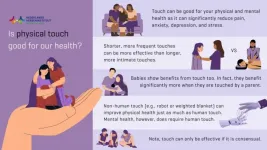(Press-News.org) Philadelphia, April 8, 2024 – Researchers from Children’s Hospital of Philadelphia (CHOP) found that teens and young adults with mood disorders, such as depression and bipolar disorder, were 30% less likely to obtain their driver’s license than peers without such disorders. Additionally, those youths with mood disorders experienced a slightly elevated risk of crashing. These findings suggest that these teens and young adults could benefit from guidance on obtaining licensure and accessing training to avoid crashes when they are newly licensed.
The findings were published online today by the journal JAMA Network Open.
Mood disorders can broadly impact physical and emotional well-being, and as many as 1 in 10 teens and young adults have been diagnosed with one. Importantly, these disorders often develop at the age when individuals are eligible to get a driver’s license. Skills that are required for safe driving, such as attention, memory and motor skills, are often impaired in those diagnosed with mood disorders.
The Center for Injury Research and Prevention (CIRP) at CHOP has been conducting research for the past several years on adolescents and young adults with neurodevelopmental differences and mental health conditions and the challenges they face prior to and following licensure. This research has examined their rates of licensure and risk of crashing to help establish the epidemiologic foundation for future translational research. With this scientific foundation for driving safety for different populations, researchers can gain a better understanding of the factors that will help inform evidence-based guidance for families regarding driving readiness and driving instruction.
This study sought to address the gap in the literature on driving and mood disorders in youths since most prior driving studies focused on adults, and young drivers are different from adults given their developmentally related crash risks. This is the first study to utilize a longitudinal cohort with objective outcome measures to report on licensure and driving outcomes for youths with mood disorders.
“Our study is the first to identify adolescents and young adults with mood disorders within a large sample to evaluate objective measures of licensing and driving outcomes when newly licensed,” says Christopher E. Gaw, MD, MPH, MBE, lead author of the study and a pediatric emergency medicine physician in the Division of Emergency Medicine at Nationwide Children’s Hospital, who conducted this research while at CHOP. “Obtaining a driver’s license is an exciting milestone for many teens and young adults, but our study found that youths with mood disorders are 30% less likely to acquire a driver’s license than their peers without mood disorders. We need to find ways to help them stay mobile so that they can lead healthy, full lives.”
The retrospective cohort study used the New Jersey Safety and Health Outcomes (NJ-SHO) Data Warehouse to examine both licensure and driving outcomes among adolescents and young adults with mood disorders. Researchers identified a cohort of 89,074 patients in CHOP’s health care network who were born from 1987 through 2000 and linked their electronic health data with New Jersey driver licensing and crash data. They followed 1,879 youths with mood disorders and 84,294 youths without a mood disorder who were age-eligible for licensure to determine the associations between mood disorders and driver’s licensure and other driving outcomes.
In addition to being less likely to acquire a license compared with their peers without mood disorders, young drivers with mood disorders in the study population had slightly higher overall crash rates at both 12- and 48-months (16% and 19% higher, respectively) after obtaining their license.
Additionally, young drivers with mood disorders were more likely to experience increased rates of at-fault crashes, night crashes, alcohol-related crashes and moving violation citations. Young drivers with mood disorders had nearly double the rate of license suspensions compared to peers without mood disorders.
“Our results indicate that newly licensed youths with mood disorders have a greater risk of crashing than other young drivers but that this is a manageable risk,” says senior study author Allison E. Curry, PhD, MPH, associate professor of Pediatrics at CIRP at CHOP and principal investigator for the NJ-SHO Center for Integrated Data. “Our findings point to the need to develop evidence-based training and education for adolescents and young adults with mood disorders who want to drive.”
This study was supported by the Eunice Kennedy Shriver National Institute of Child Health and Human Development at the National Institutes of Health Awards R01HD079398 and R01HD096221.
Gaw et al, “Driver’s Licensure and Driving Outcomes Among Youths with Mood Disorders.” JAMA Netw Open. Online April 8, 2024. DOI: 10.1001/jamanetworkopen.2024.5543.
About Children’s Hospital of Philadelphia:
A non-profit, charitable organization, Children’s Hospital of Philadelphia was founded in 1855 as the nation’s first pediatric hospital. Through its long-standing commitment to providing exceptional patient care, training new generations of pediatric healthcare professionals, and pioneering major research initiatives, the hospital has fostered many discoveries that have benefited children worldwide. Its pediatric research program is among the largest in the country. The institution has a well-established history of providing advanced pediatric care close to home through its CHOP Care Network, which includes more than 50 primary care practices, specialty care and surgical centers, urgent care centers, and community hospital alliances throughout Pennsylvania and New Jersey, as well as the Middleman Family Pavilion and its dedicated pediatric emergency department in King of Prussia. In addition, its unique family-centered care and public service programs have brought Children’s Hospital of Philadelphia recognition as a leading advocate for children and adolescents. For more information, visit https://www.chop.edu.
END
Youths with mood disorders 30 percent less likely to acquire driver’s license than peers
First large-scale study on licensure and driving outcomes among teens and young adults with mood disorders also finds overall crash rates slightly higher for those newly licensed
2024-04-08
ELSE PRESS RELEASES FROM THIS DATE:
Opening a new front against pancreatic cancer
2024-04-08
NEW YORK, NY (April 8, 2024)--A new type of investigational therapeutic in development for pancreatic cancer has shown unprecedented tumor-fighting abilities in preclinical models of the disease, suggesting it has the potential to offer novel treatment options for nearly all pancreatic tumors, a comprehensive study has found.
The inhibitors in this new class of oral medications, being developed by Revolution Medicines Inc., target the oncogenic or active cancer-causing form of RAS proteins (such as KRAS, NRAS, and HRAS). These RAS “oncoproteins” drive up to a third of all human cancers. The research ...
More premature babies born following Swedish parental leave policy
2024-04-08
The introduction of a policy protecting parental leave benefits in Sweden in 1980 had unintended consequences on child health. The policy led to an increase in premature birth rates. This is shown by a study from researchers at Stockholm University, published in JAMA Pediatrics.
The Swedish so-called speed premium policy was introduced in 1980 in order to protect couples’ level of income-based parental leave benefits when they had children in quick succession. The new study from Stockholm University evaluates the health consequences of the policy. The researchers conclude that by ...
Immune key to chronic viral infections discovered
2024-04-08
IMMUNE KEY TO CHRONIC VIRAL INFECTIONS DISCOVERED
Australian researchers have discovered a previously unknown rogue immune cell that can cause poor antibody responses in chronic viral infections. The finding, published today (9 April) in the journal, Immunity, may lead to earlier intervention and possibly prevention of some types of viral infections such as HIV or hepatitis.
One of the remaining mysteries of the human immune system is why a certain cell, called a B cell, which retains a memory for past infections – ensuring we fight off diseases we have experienced before – often only has a weak capacity to protect us from persistent infections.
Researchers ...
PFAS ‘forever chemicals’ above drinking water guidelines in global source water
2024-04-08
Per-and poly-fluoroalkyl substances – commonly known as PFAS – are a group of over 14,000 human-made chemicals that have been popular since the 1950s for their diverse skills in resisting heat, water, grease and stains.
They’ve been commonly found in household products like non-stick frypans, clothing, cosmetics, insecticides, and food packaging, as well as specialty industry products, like firefighting foam.
But despite their broad skillset, the chemicals have a dark side: they’re known as ‘forever chemicals’ as once they’re in the environment – ...
How the moon turned itself inside out
2024-04-08
About 4.5 billion years ago, a small planet smashed into the young Earth, flinging molten rock into space. Slowly, the debris coalesced, cooled and solidified, forming our moon. This scenario of how the Earth's moon came to be is the one largely agreed upon by most scientists. But the details of how exactly that happened are "more of a choose-your-own adventure novel," according to researchers in the University of Arizona Lunar and Planetary Laboratory who published a paper in Nature Geoscience. The findings offer important insights into the evolution ...
Climate change threatens Antarctic meteorites
2024-04-08
Using artificial intelligence, satellite observations, and climate model projections, a team of researchers from Switzerland and Belgium calculate that for every tenth of a degree of increase in global air temperature, an average of nearly 9,000 meteorites disappear from the surface of the ice sheet. This loss has major implications, as meteorites are unique samples of extraterrestrial bodies that provide insights into the origin of life on Earth and the formation of the Moon.
Disappearing at an alarming rate
By 2050, about a quarter of the estimated of 300,000 - 800,000 meteorites in Antarctica will be lost ...
New study highlights the benefit of touch on mental and physical health
2024-04-08
Through a large-scale analysis, researchers at the Netherlands Institute for Neuroscience have uncovered the ways in which consensual touch can benefit a person’s physical and mental wellbeing.
You might recognize the comforting feeling when someone offers you a hug at the end of a stressful day or strokes your shoulder when you’re feeling down. But the question remains: can touch really help you feel better, and does it matter who it’s from or how they touch you? To explore these questions, researchers from the Social Brain Lab at the Netherlands Institute for Neuroscience and the University Hospital ...
Wyss Institute’s AminoX project receives funding from Northpond Labs to accelerate innovation in protein-based therapeutics
2024-04-08
(BOSTON) — The Wyss Institute for Biologically Inspired Engineering at Harvard University and Northpond Ventures announced today that the VC firm’s affiliate Northpond Labs has signed an agreement to support the development of the AminoX project toward commercialization. This is the fourth Wyss project selected by Northpond Labs for additional funding.
Established in 2020 with the involvement of Harvard’s Office of Technology Development, the five-year strategic research alliance created The Laboratory for Bioengineering Research and Innovation at the Wyss Institute through a $12 million commitment from Northpond Labs to support impactful research ...
How scientists are accelerating chemistry discoveries with automation
2024-04-08
A new automated workflow developed by scientists at Lawrence Berkeley National Laboratory (Berkeley Lab) has the potential to allow researchers to analyze the products of their reaction experiments in real time, a key capability needed for future automated chemical processes.
The developed workflow – which applies statistical analysis to process data from nuclear magnetic resonance (NMR) spectroscopy – could help speed the discovery of new pharmaceutical drugs, and accelerate the development of new chemical reactions.
The Berkeley Lab scientists who developed the groundbreaking technique ...
An inside look at how plants and mycorrhizal fungi cooperate
2024-04-08
For millions of years, underground fungi have lived in symbiosis with plant roots. Plants provide photosynthesized carbon, while fungi deliver water and nutrients. In order to do so, these organisms share space at cellular scale: fungi stretch a network of tendrils called arbuscules into a plant’s root cells, and both organisms rearrange their cells around this structure to facilitate sharing.
Recently, researchers have been able to study both sides of this interaction up close, using RNA sequencing to understand gene expression: one of the first cross-kingdom spatially-resolved transcriptomics studies to date. This paper ...
LAST 30 PRESS RELEASES:
Why nail-biting, procrastination and other self-sabotaging behaviors are rooted in survival instincts
Regional variations in mechanical properties of porcine leptomeninges
Artificial empathy in therapy and healthcare: advancements in interpersonal interaction technologies
Why some brains switch gears more efficiently than others
UVA’s Jundong Li wins ICDM’S 2025 Tao Li Award for data mining, machine learning
UVA’s low-power, high-performance computer power player Mircea Stan earns National Academy of Inventors fellowship
Not playing by the rules: USU researcher explores filamentous algae dynamics in rivers
Do our body clocks influence our risk of dementia?
Anthropologists offer new evidence of bipedalism in long-debated fossil discovery
Safer receipt paper from wood
Dosage-sensitive genes suggest no whole-genome duplications in ancestral angiosperm
First ancient human herpesvirus genomes document their deep history with humans
Why Some Bacteria Survive Antibiotics and How to Stop Them - New study reveals that bacteria can survive antibiotic treatment through two fundamentally different “shutdown modes”
UCLA study links scar healing to dangerous placenta condition
CHANGE-seq-BE finds off-target changes in the genome from base editors
The Journal of Nuclear Medicine Ahead-of-Print Tip Sheet: January 2, 2026
Delayed or absent first dose of measles, mumps, and rubella vaccination
Trends in US preterm birth rates by household income and race and ethnicity
Study identifies potential biomarker linked to progression and brain inflammation in multiple sclerosis
Many mothers in Norway do not show up for postnatal check-ups
Researchers want to find out why quick clay is so unstable
Superradiant spins show teamwork at the quantum scale
Cleveland Clinic Research links tumor bacteria to immunotherapy resistance in head and neck cancer
First Editorial of 2026: Resisting AI slop
Joint ground- and space-based observations reveal Saturn-mass rogue planet
Inheritable genetic variant offers protection against blood cancer risk and progression
Pigs settled Pacific islands alongside early human voyagers
A Coral reef’s daily pulse reshapes microbes in surrounding waters
EAST Tokamak experiments exceed plasma density limit, offering new approach to fusion ignition
Groundbreaking discovery reveals Africa’s oldest cremation pyre and complex ritual practices
[Press-News.org] Youths with mood disorders 30 percent less likely to acquire driver’s license than peersFirst large-scale study on licensure and driving outcomes among teens and young adults with mood disorders also finds overall crash rates slightly higher for those newly licensed




